
I recently came across a reference to gold being worked at Cross Gill in the North Pennines. It’s in an 1873 article - On the Occurrence of Lead, Zinc, and Iron Ores, in some Rocks of Carboniferous Age in the North-West of England, by De Rance. This 18 page article, subtitled Mineral Veins in the North-West Country, was published in The Geological Magazine; or Monthly Journal of Geology, Volume 10. The full article is at the end of this blog post.
Although I’d been researching any gold finds in Northern England, there are other noteworthy titbits, one which caught my attention was about a lead mine at Anglezarke, Lancashire. I’d never heard of the location. Apparently William Withering obtained samples of an unknown mineral from the mine, then identified its composition (as opposed to baryte), and later had the mineral named after him - witherite. I thought that the specimens for Withering’s analysis had come from Alston Moor (TL), so I looked into the history of Withering, Witherite and the Anglezarke connection…..
My own experience with witherite began when I collected an apple sized specimen of beautifully crystallised barium carbonate from mine spoil-heaps between Lanchester, Burnhope and Annfield Plain, Co. Durham in 1972. Witherite was discovered by miners in 1928 while working the Hutton coal-seam, deep in the Morrison North Pit, Annfield Plain. The coal miners must have been bemused to suddenly have snow-white rock to deal with. Worth more than three times the value of coal, the vein was to become quite a bonanza, and became a very important asset during WW2. Of course the miners had to get used to a completely different method of working, the almost vertically running vein requiring stoping, a foreign concept to pit-men. The total output from 1932 to 1958 was 233,579 tons.
Back home from collecting, I washed mud from the witherite in the kitchen sink, using a toothbrush and tepid water. It exploded. The rock completely shattered in my hands with a loud bang, much to the dismay of myself; a specimen lost, and to my Mother; her 12 year old son having just inundated her kitchen with toxic barium carbonate dust and particles! My Dad blustered into the kitchen, muttering about “witherite poisoned pit-ponies” and “being used to make bombs in the war.” As explosions go, it was minor, merely released internal stresses in the specimen, possibly from a high pressure inclusion.
Witherite, or barium carbonate, isn’t in any way a chemical explosive. However my Dad was right, it was used in the war to make barium nitrate (by its reaction with nitric acid), a chemical widely used in military explosives.
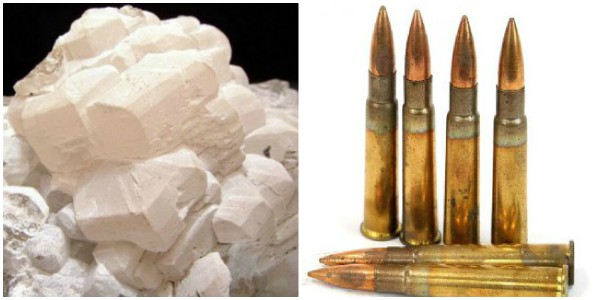
The nitrate was used as a non-corrosive oxidiser in the primers in millions of .303 rifle cartridges.
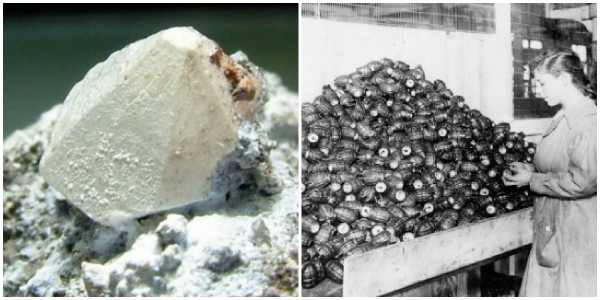
It was a 75% constituent of the high-explosive Baratol, the rest being TNT. Baratol is a slow-detonating explosive, used in hundreds of thousands of British hand grenades, the Mills. Witherite has a dark side…. People die.

It gets worse…. The Fat Man, a plutonium atomic fission bomb, was dropped on Nagasaki on the 9th of August, 1945. It used Baratol as the slow component of the explosive lenses which imploded the plutonium core. A combination of fast and slow high explosives, precisely manufactured to calculated profiles, was essential for the Pu to be compressed uniformly, otherwise the bomb wouldn’t work. Witherite was one of the absolutely necessary raw materials required to make one bomb instantly kill 40,000 people…….
Whether witherite mined at the Morrison Busty was actually used to make the baritol explosive in Fat Man can’t be determined, but the probability is not insignificant -
“From the first production in 1932 to the closure in 1958, the mine has produced between 6,000 tons and 16,000 tons of high grade witherite per annum. Considering the fact that at that time the production of witherite throughout the world was only about 20,000 tons to 25,000 tons per annum, then with this mine at Burnhope, Co. Durham, together with a similar mine at Settlingstones near Hexham, Northumberland, the majority of the world's witherite production was concentrated in the north-east of England.”
As a side note, barium nitrate needn’t be prepared from witherite. It occurs naturally as the very rare mineral, Nitrobarite. Barium nitrate isn’t itself explosive, so the micromounts of this mineral are quite safe. Unless mixed with TNT!

My Dad lived in Annfield Plain, where the Morrison Busty Colliery was. My Granda was the winding man at the pit. They both told me stories about local miners having “bonny bits” on their mantle-pieces, but didn’t know the witherite workers too well, and never managed to scrounge a specimen for me. The crystals the miners liberated would have been superb, given the vuggy nature of the vein. This (as with the previous quote) from Mining Witherite in North-West Durham, Ashburn, 1963 -
“The thickness of the witherite varied greatly from minute hair veins in the fault breccia up to about 12 ft. of mineral filling the fault plane. An exceptional thickness of 22 ft. occurred at the junction of the veins and was known as the "Bonanza" area which extended for about 100 ft. in length. The inclination of these veins varied from 75 deg. to 80 deg……. Occasionally cavities were found of considerable size, and the biggest one, on the main haulage level, contained water. The depth of this cavity could not be ascertained and several days of continual dumping of debris was required before a suitable floor was obtained for the working to proceed. In another case, a cavity found in the upper levels was 20 ft. long, 10 ft. high and 3 ft. 6 in. wide.”
The surreptitious removal of any witherite specimens from the Morrison Busty during wartime, would have been looked at very harshly - it was a Strategic Mineral, vital to the war effort. However… I wonder how many beautifully crystallised “bonny bits” languish in boxes in the attics of Annfield Plain, with the rest of someone's grandparents’ junk treasures.
The poisoned pit-ponies my Dad had mentioned (when he realised our kitchen had become a little dangerous) were an example of how toxic witherite is. Pit-ponies lived underground. And their fodder was transported to the subterranean stables using coal tubs. Unfortunately one of the tubs was used to transport witherite. Then it was used to deliver the ponies’ food. Several died down the Morrison Busty.
Only one man died from witherite at the mine workings. He wasn’t poisoned. He had been driving a 45 degree rise, from the Hutton level to the surface, for ventilation and ore transport (its surface opening is where I’d collected). He hit the witherite vein and, “was trapped by the legs when fine sugarlike witherite fell from the face of the rising drive, and he was eventually buried by the mineral and died from asphyxia.”
Aerated Barytes, James “Dog-Killer” Watt, and a few Lunatics
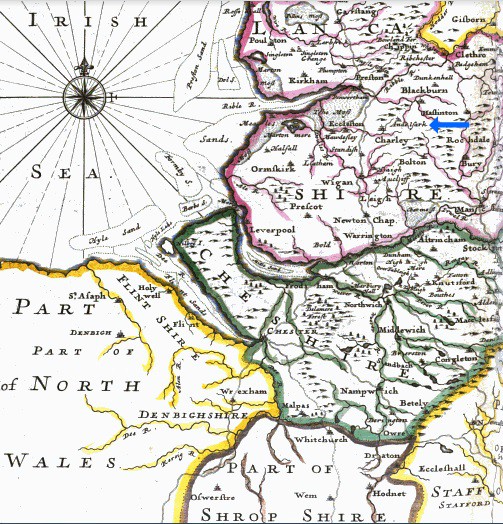
The Anglezarke Poisonings. The toxicity of witherite was known about, even before the mineral had a name. In 1692 lead mining began at Anglezarke, near Chorley in Lancashire (above), a settlement of scattered farmhouses with no village centre. The galena they were after, was associated with barium minerals, then considered as unknown gangue and dumped. The gangue was known as “terra ponderosa” or ”aerated barytes,” and was a dangerous environmental hazard. Local farmer Mr. Derbyshire had several cows and all his fowl die from from it. Witherite from the spoil heaps was used by locals as rat-poison, and as an emetic and purger on themselves, in the belief such medical administration was of the same value of blood-letting.
Some folk overdid it. When farmer James Barns’ wife and child became ill, he decided a decent purging would do them the world of good. After administering a generous dose of “Terra Ponderosa” from Anglezarke mine to each, he spent the next nine hours watching them die. Some idea of the horror of witherite toxicity can be gleaned from this account of the mass poisoning of 27 armed police in Chittagong, Bangladesh.
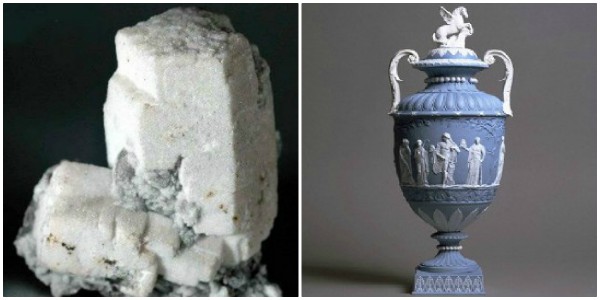
Josiah Wedgwood, pottery entrepreneur. This ceramicist was a potter with enquiry and experimentation at his heart. Although his creations were in demand, for their fineness of design and finish, he constantly strove to find different formulations of the clays, slips, glazes and oxides for his pottery. He sought out any new “earths” to try and create ceramics of a novel nature. By virtue of over 10,000 experiments, Wedgwood formulated Jasperware, pictured above. This from The Dictionary of National Biography, Leslie Stephen, 1899
“He was endeavouring to compound a paste of fine texture allied to true porcelain, but endued with certain properties, which no hard or soft china previously made had possessed. He found the very substance required in certain mineral compounds of the earth baryta. The distinctive character of this earth seems to have been first made out in 1779 by Guyton de Morveau, while William Withering four years afterwards recognised the same base in a mineral carbonate from Leadhills, Lanarkshire. But Wedgwood, so early as 1773 was making trials of both these minerals. He was puzzled by the apparently capricious behaviour of these two compounds, but learnt where to obtain and how to recognise the more important of the two, the sulphate of baryta or cawk, which became henceforth the chief and characteristic constituent of his 'jasper,' although a small quantity of the carbonate of baryta was occasionally added to the mixture. One of Wedgwood's early recipes for this new jasper body, when translated into percentages, approaches these figures—sulphate of baryta 59, clay 29, flint 10, and carbonate of baryta 2. Within rather wider limits these proportions were varied with corresponding variations in the properties, texture, and appearance of the product. But the product was a ceramic novelty, a smooth paste of exquisite texture, without positive glass, yet so compact as to admit of being polished, like native jasper.”
Note that the above mentions that Withering’s analysis was performed on specimens from Leadhills, Scotland, contrary to the Anglezarke location mentioned in De Rance’s article, at the foot of this document.
Wedgewood endeavored to keep his formulations very secret, for fear of copying from other potters. However, he needed expert help and advice on the two uninvestigated “earths.” Specifically since the Terra Ponderosa or Aerated Barytes, was toxic and he was making posh teapots with it! He needed expert help. Fortunately, he was a lunatic.
The illustrious steam-engineer James Watt, was mates with William Withering. They met, once every month, on the Monday nearest to the full moon. This was in the days of highwaymen and footpads (robber or thief specialising in pedestrian victims), and the moonlight illuminated their homeward journeys, offering a degree of security. Other science and engineering folk, who met with Watt and Withering on moonlit Monday nights, included Josiah Wedgwood the potter, engineer and mineral collector Matthew Boulton, and chemist Joseph Priestley. Usually about a dozen of Britain’s finest minds would meet monthly at Soho House, Birmingham, to chew the scientific cud over a meal and a few pints. They called themselves “The Lunar Society,” and themselves, lunatics. Priestley, Boulton and Withering soon helped Wedgewood with his investigations, and the nature of the “earths” became apparent. Unfortunately, James Watt’s son got involved.
James Watt Jnr., Dog-Killer. What this guy did as “scientific research” beggars belief! The knowledge at the time was that “terra ponderosa” was lethal to both humans and animals. No further investigation was required. I’ve always enjoyed having one of my dogs with me whilst collecting (I’d had Mac, a black labrador, with me at Lanchester, collecting witherite). So I find the work of Watt Jnr., highly disturbing. Here’s his experimental details from 1789, if you’ve the stomach for it. Suffice to say that, in a series of 7 experiments in the second part of his essay, he sacrificed the health of dogs and puppies on the altar of natural philosophy. All just to further prove the toxicity of “terra ponderosa,” and it’s barium salts. The first part of Dog-Killer’s essay, a discussion about Anglezarke’s lead mine and Withering’s contribution, is safe to read, and contains this -
“The first intimation of the Aerated Barytes existing naturally was given by Dr Withering, who published an excellent analysis of it in the Philosophical Transactions for the year 1784, wherein he has left us little to desire respecting its chemical properties. However he was misinformed as to the place from whence his specimen came, which he supposed to be Alston Moor, where I have good authority for advancing that none has been found. He has since informed me that he believes it came from the same mine of Anglezarke which forms the subject of the present paper.”
Dog-Killer is of course wrong about Alston Moor having no witherite (see pics below), but if his assertion, that Withering laterly believed his analytical specimens to be from Anglezarke, is correct, then the type-locality of Alston Moor for witherite (noted on Mindat as pinned down to Brownley Hill Mine, ref. Mineralogical Record Vol. 31, No. 3 May - June 2000), is in doubt.

Withering’s original paper of 1784, Experiments and Observations on the Terra Ponderosa can be found here, and it’s first sentence -
“This substance was got out of a lead mine at Alston Moor in Cumberland. I first saw it in the collection of my worthy and ingenious friend Matthew Boulton Esq., at Soho.”
To thoroughly muddy the waters, wikipedia has this to say -
“The Matthew Boulton mineral collection of Birmingham Museum and Art Gallery may contain one of the earliest known specimens of witherite. A label in Boulton's handwriting, records: "No.2 Terra Ponderosa Aerata, given me by Dr. Withering.”
So… we have three different possible type-localities for Withering’s witherite: Alston Moor, Anglezarke and Leadhills, plus the confusion about who gave what to whom. Such is history, it’s not a quantifiable subject, being only our interpretation of what long-dead folk wrote.
STOP PRESS - Just as I'd finished this little article, Mark the e-Rocks boss threw some new info into this conundrum. The path I'd been treading, researching this type-locality issue, is a well worn trail! In the March 1963 issue of Mineralogical Magazine, there's a short communication "The type-locality of witherite" by J.Selwyn Turner, online here.
It starts, "Some confusion exists over the original locality from which witherite was described," you're not kidding Selwin!
In it there are the following gems -
Kingsley Dunham cited Anglezarke Moor
Dana printed Alston Moor
Miers favoured Anglezarke
Werner went for Alston Moor
It finishes, "No final solution to the problem seems possible, but the claims of Anglezarke rest on a more shaky foundation than those of Alston Moor." I myself lean towards Alston Moor, having doubts about "Dog Killer" Watt's character! However, since Mindat has confidence in pinning down Brownley Hill Mine as type locality, there must be information missed by J.Selwyn Turner and myself, present in the 2000 issue of Mineralogical Record. If a reader has a copy of this issue (Vol. 31, No. 3 May - June) to hand, please let us know what the reference is, in the comments section below. Cheers, & back to the article. START PRESS.
However, a handful of things about William Withering which are nailed down - he was a bright lad, whose investigations on the medical effects of digitalis from foxgloves (for heart problems) are of massively superior importance to any mineralogical work. Also, he was a doctor who gave treatment free of charge to poor folk. And was blessed with a caustic wit - his response to a duelling challenge, is related below the photo of the author of An Account of the Foxglove and its Medical Uses.

“Sir, I received your note; the purport of which if I am not mistaken, is a request that I would fix upon a time and place that you may have the opportunity to kill me. But it further implies that I may also have the opportunity of killing you; and this you call satisfaction. It may be so to you. Permit me, however, to assure you that it would be no satisfaction to me to kill you, or any other man; therefore, until our ideas can be more properly adjusted, you must allow me to decline to meet you.”
Before finishing this rather bloated blog post, here’s some nuggets of (hopefully interesting) information from the section “On Barytes,” in Chemical Essays, by Samuel Parkes, 1830. Parkes says this about a baryte specimen, before dealing with witherite, “In Mr Hutton's museum at Keswick in the county of Cumberland there is a single crystal which is perfectly formed and weighs 29lbs 2oz….. This curious specimen was found near Cross Fell in the county of Cumberland.”
The article goes on to describe the activity of a certain Mr. James Smithels, the world’s first witherite thief -
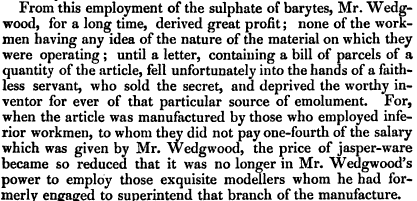

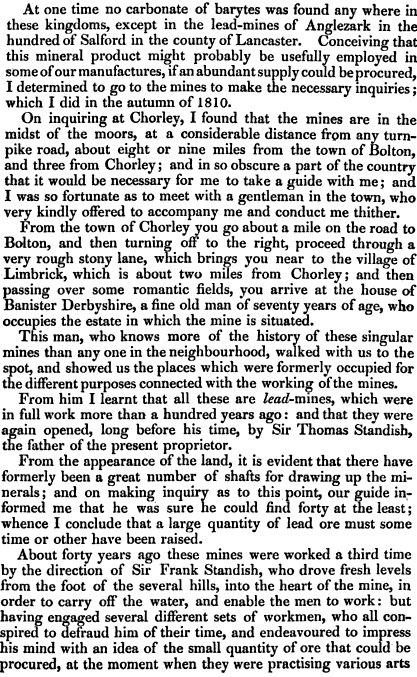
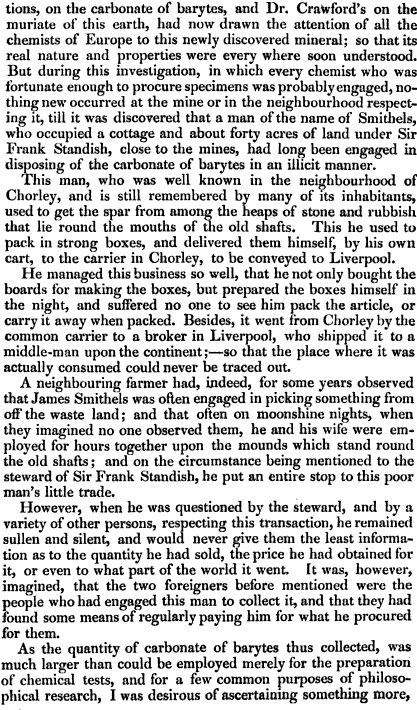
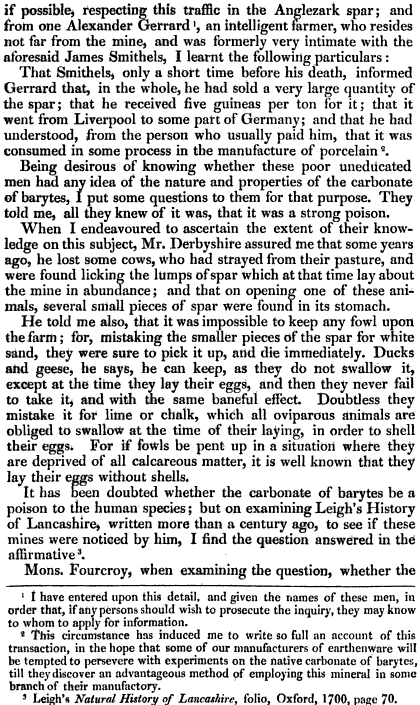
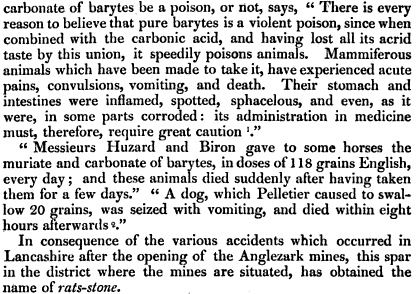
Lastly, here’s the 18 page De Rance article from 1873, which got me going on witherite. It’s a bit long winded, and for anyone wanting detailed information on my original quest, Pennines gold, underwhelming! However, if you manage to wade through it, I’ve put a nice auriferous video at the end.
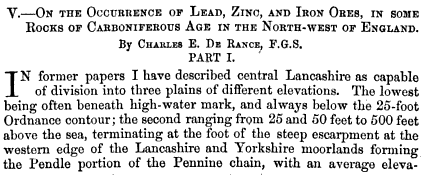
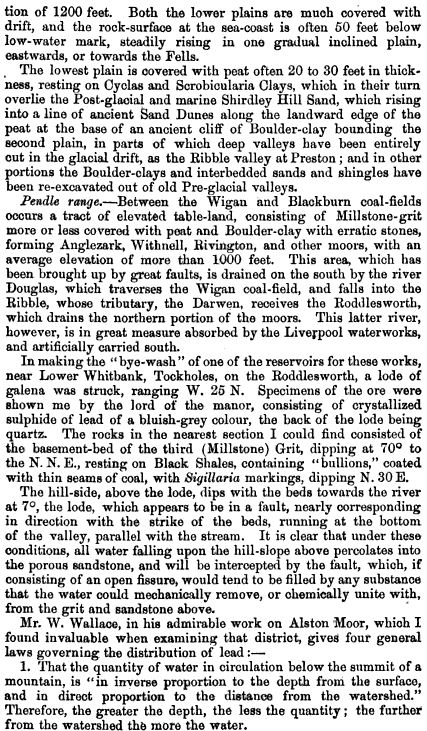
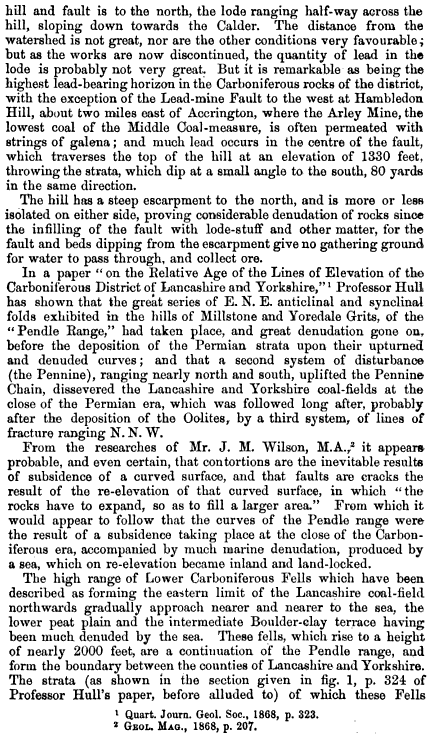
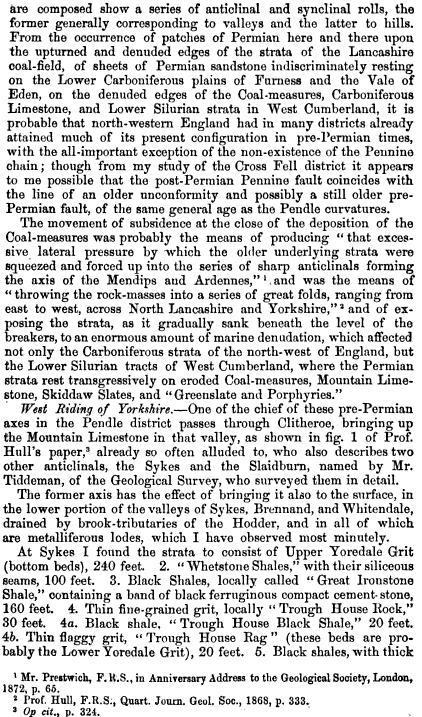








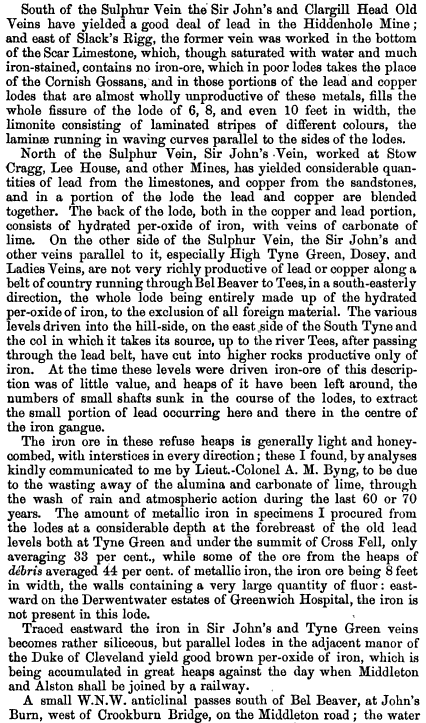

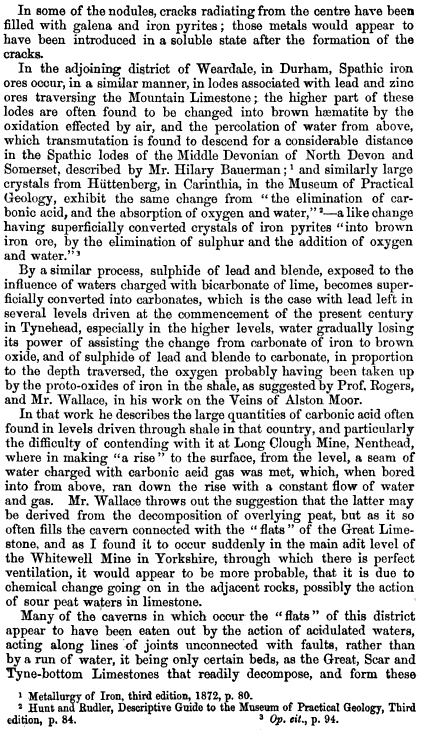
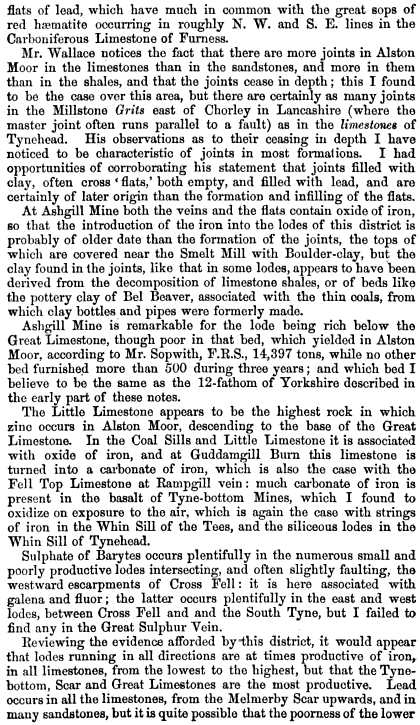

References:
Mining Witherite in North-West Durham, Ashburn, 1963
Mass barium carbonate poisoning with fatal outcome, Aniruddha Ghose, 2009
The Dictionary of National Biography, Sir Leslie Stephen, 1899
Some Account of a Mine in which the Aerated Barytes is Found, James Watt Jnr, 1789
Experiments and Observations on the Terra Ponderosa, William Withering, 1784
Chemical Essays, Samuel Parkes, 1830
The type-locality of witherite, J.Selwyn Turner, 1963
And Now for Something Completely Different
______________________________